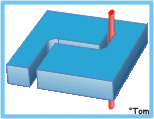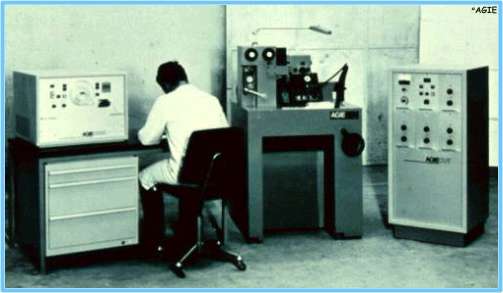
|
|
This is Wire EDM |

|
|
This is Wire EDM |
No, wire EDM (Electro Discharge Machining) was not developed at AGIE. Similarly to the general Electro Discharge machining, first developed by the Soviet couple Lazarenko (ca. 1943), the first machine using a continuous wire electrode to cut contours in metal, was also created in the then USSR. This was a very simple machine, which was not programmable in that sense, but followed a shaped metal plate or template, which had first to be produced by other means, such as a milling machine or by hand with files and sandpaper. This machine never reached a stage which would allow it to be produced in high volume and sold to tool and die makers. It is quite apparent that the possibilities of such a machine were not recognized and that the necessary funds were not available. One must nevertheless acknowledge that AGIE played an absolute pioneer-role in this domain, developing a machine that was imitated by other manufacturers only years later.
It was most likely in 1967 or 1968, when W.U. saw this machine at an exhibition in Moscow, and took the idea with him to Switzerland, to create a new product for AGIE. The far-sightedness of W.U. proved to be a real revolution in the years to come, forcing the entire tool- die- and mold makers to rethink the ways they produced their toolings. Once the technique was fully established, other manufacturing processes also took advantage of wire EDM machines.
Back in Losone, he started immediately a study to find out what possibilities such a machine could have in the market. From the early stages on, he determined that it should not be a machine following the Soviet model, but a numerically controlled one, being able to cut highly accurate shapes with minimum human supervision. A thin copper or brass wire as electrode had already been used on smaller ram-type EDM machines, to produce narrow slots or to separate exotic or expensive materials. The technology therefore was not that new.
Several teams were appointed to develop the various components: the machine tool itself, the generator and the numerical control.
 |
|
The first AGIECUT DEM-15 (1969) |
For the machine tool, internal personnel under the supervision of A.S. and M.M. could be appointed, which, with a tiny budget, had to develop AGIE's first version of a DEM machine (from German: Draht Erodier Maschine, Wire Erosion Machine). The initial travel for the two axes was fixed to be 150 x 150 mm (approx. 5.9" x 5.9"), nobody at this stage assumed that anybody would want to cut larger workpieces on such a machine. Everybody was very, very skeptical., it was a domain nobody knew anything about.
The part that presented the smallest problems was the generator, a model already in use for small desktop ram-type machines could be adapted. This domain was left to the able hands of E.L., which at that time was responsible within AGIE for the development of generators.
The biggest problem was the numerical control. In this field, AGIE had neither expertise nor personnel. This meant that the NC unit had to be developed externally. How the Technical University of Hanover, Germany, was selected is not very clear, it seems that W.U. already had other devices developed there (later he also received his DR. h.c. from that university).
Here again, the budget made available was really very small, and nothing could be "copied" from existing controllers, there was nothing of that kind on the market yet. For this project, H.R. and V.S. were recruited. The two, with their team, really developed a remarkable controller, remembering that the technique of the numerical controls was in their absolute beginnings, in those years, machines following templates (mostly for lathes) where still very new and the first machines where the travels of the axes were determined by positioning cams along a rail were used. Other machines used panels with holes and plugs to "program" the repetitive movements and functions.